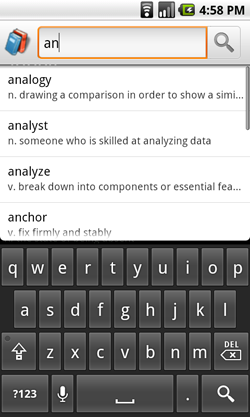The ability to search is considered to be a core user feature on Android. The user should be able to search any data that is available to them, whether the content is located on the device or the Internet. This experience should be seamless and consistent across the entire system, which is why Android provides a simple search framework to help you provide users with a familiar search dialog and a great search experience.

Android's search framework provides a user interface in which the user can perform a search and an interaction layer that communicates with your application. This way, you don't have to build a search box that the user must find in order to begin a search. Instead, a custom search dialog will appear at the top of the screen at the user's command. The search framework will manage the search dialog and when the user executes their search, the search framework will pass the query text to your application so that your application can begin a search. The screenshot to the right shows an example of the search dialog (using search suggestions).
Once your application is set up to use the search dialog, you can:
The following documents will teach you how to use the search dialog in your application:
Also, the Searchable Configuration document provides a reference for the searchable configuration file (though the above documents also discuss the configuration file in terms of specific behaviors).
Note: The search framework does not provide APIs to
perform searches on your data. Performing actual searches is a task that you must accomplish
using APIs appropriate for your data, such as those in android.database.sqlite
if your data is in an SQLite database.
When you implement search in your application, you should take steps to protect the user's privacy whenever possible. Many users consider their activities on the phone, including searches, to be private information. To protect the user's privacy, you should abide by the following principles:
"Personal information" is information that can personally identify your users, such as their name, email address, billing information, or other data which can be reasonably linked to such information. If your application implements search with the assistance of a server, try to avoid sending personal information along with the search queries. For example, if you are searching for businesses near a zip code, you don't need to send the user ID as well — send only the zip code to the server. If you must send the personal information, you should take steps to avoid logging it. If you must log it, you should protect that data very carefully and erase it as soon as possible.
The search framework helps your application provide context-specific suggestions while they type.
Sometimes these
suggestions are based on previous searches, or other actions taken by the user in an earlier
session. A user may not wish for previous searches to be revealed to other users, for instance if
they share their phone with a friend. If your application provides suggestions that can reveal
previous activities, you should implement a "Clear History" menu item, preference, or button. If you
are
using SearchRecentSuggestions, you can simply call its clearHistory() method. If you are implementing custom
suggestions, you'll need to provide a
similar "clear history" method in your provider that can be invoked by the user.